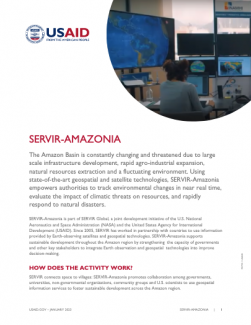The Amazon Basin is constantly changing and threatened due to large scale infrastructure development, rapid agro-industrial expansion, natural resources extraction and a fluctuating environment. Using state-of-the-art geospatial and satellite technologies, SERVIR-Amazonia empowers authorities to track environmental changes in near real time, evaluate the impact of climatic threats on resources, and rapidly respond to natural disasters.
SERVIR-Amazonia is part of SERVIR Global, a joint development initiative of the U.S. National Aeronautics and Space Administration (NASA) and the United States Agency for International Development (USAID). Since 2005, SERVIR has worked in partnership with countries to use information provided by Earth-observing satellites and geospatial technologies. SERVIR-Amazonia supports sustainable development throughout the Amazon region by strengthening the capacity of governments and other key stakeholders to integrate Earth observation and geospatial technologies into improve decision-making.
HOW DOES THE ACTIVITY WORK?
SERVIR connects space to villages: SERVIR-Amazonia promotes collaboration among governments, universities, non-governmental organizations, community groups and U.S. scientists to use geospatial information services to foster sustainable development across the Amazon region.
RESULTS ACHIEVED TO DATE
To make geospatial information easily accessible to decision makers such as indigenous communities and/or government authorities, SERVIR has already co developed several tools:
- It is now possible to track gold mining (gold) activities and deforestation in the Amazon regardless of weather conditions and in near real time with the use of Earth observation satellites.
- This information is available through the Radar Mining Monitoring Tool (RAMI) that MINAMis using to better monitor gold mining.
- The Deforestation Monitoring and Reporting in Ecuador service that contributes to the Ministry of Environment and Water of Ecuador goals to effectively estimate emissions reduction and enroll in results-based payments in order for communities’ to sustain their conservation efforts.
- The TerraOnTrack web application that introduces resources that allow traditional communities and indigenous people in the Para State of Brazil to quickly identify potential threats to their territories and monitor illegal activities on the ground. This in turn will increase forest protection and territorial management capacity.
- The Improving Resilience and Reducing Risk of Extreme Hydrological Events provides stakeholders such as SENMAHI, INAMHI and IDEAM with improved flood forecasting ability in terms of timing, magnitude and impact. This information increases their understanding of risks and supports greater resiliency to flood disasters.
- Monitoring and Evaluation of Mangroves in Guyana platform makes land-use change transparent and the results publicly available to 1) act on hotspots of deforestation and stop them on time, 2) engage in land-use policy making and plan mangrove protection efforts for farmers in coastal regions.
- A cost-effective monitoring tool to assess the impact of private sector engagement on conservation in Brazil, by characterizing forest habitat and species dynamics.
- Through quantifying the effects of forest changes on provisioning and regulating ecosystems, citizens of Acre and Ucayali have stronger evidence to better understand the tradeoffs between development activities and ecosystem services.

